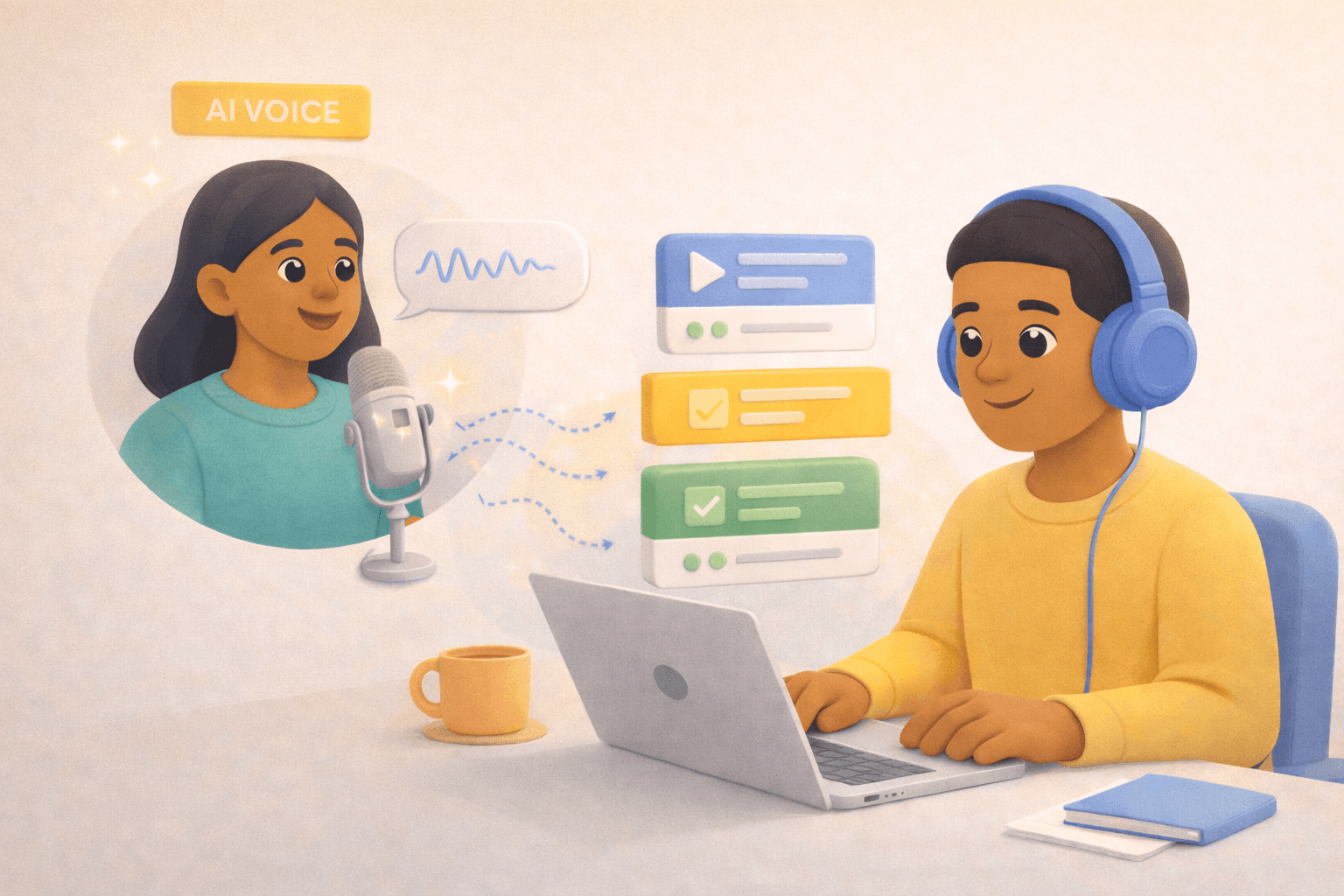Curating knowledge
How to Create Microlearning Courses with AI
Digital learning is ideally suited to most learners’ fast-paced modern lifestyles — and AI is transforming the way these courses are being produced. AI is also revolutionizing online training by providing tools and capabilities to create, market, and sell educational content and digital products. We will explore how AI is revolutionizing the creation of microlearning courses before taking you through the steps to develop an effective microlearning course using AI.

Ryan Macpherson
Jul 9, 2024



Editor:
Stephanie Chan
What is microlearning?
Microlearning involves delivering short, focused pieces of content to learners, typically designed to meet specific learning objectives. Microlearning examples include various formats and techniques such as quizzes, games, microlearning videos, action-led microlearning, short scrolling pages, microlearning masterclasses, and practical on-the-job learning. This training method is highly effective for employee training because it fits well into busy schedules, enhances retention, and aligns with the way people prefer to consume information in short bursts. Additionally, compliance training can benefit from microlearning by fulfilling legal requirements efficiently and improving retention rates.
The role of AI in creating microlearning
AI plays a crucial role in enhancing microlearning by offering the following advanced capabilities that traditional eLearning platforms typically lack:
1. Personalization: AI course creation can help tailor learning experiences to needs of specific groups or audiences. The course creator can input context about learners’ behaviors, preferences, and performance, ensuring microlearning courses are of a suitable length and tone, and contain relevant content.
2. Content creation and curation: As AI pulls from vast sources of information to create up-to-date and engaging materials, it can generate and curate high-quality microlearning content quickly and efficiently.
3. Adaptive learning paths: AI course generation can help to rapidly generate a series of microlearning courses as part of learning paths. With increased efficiency in rolling out education materials, you can create different learning paths to meet the needs of your different audiences.
4. Automated assessments and feedback: AI can rapidly generate relevant quiz assessments based on educational content, ensuring learners have the opportunity to test their understanding.
As you can see, AI makes the process of creating a microlearning course quicker and more scalable than using a traditional eLearning platform. Additionally, by automating repetitive tasks, AI can help reduce costs associated with course creation and delivery, making microlearning more accessible to organizations of all sizes. Integrating a microlearning strategy with AI can further enhance the effectiveness of training programs by enabling personalized and adaptive learning experiences.
Now, let’s talk about how you can use AI to build your next microlearning course.
Step One: Plan Your AI-Generated Microlearning Course
Effective planning is the cornerstone of any successful AI-integrated microlearning course. The better you plan, the more likely your course will be well-structured, resource-efficient, and capable of delivering a personalized and impactful learning experience. The planning stage involves the following three steps:
Identify target audience and learning needs: Understand the demographics, job roles, and skills needed by your audience. For internal users, such as employees, this involves understanding their diverse demographics, job roles, and preferred learning styles. Training content is crucial in this planning phase, as it ensures the material is concise, relevant, and tailored for mobile learning. Courses may focus on enhancing job-specific skills crucial for success in their roles or ensuring compliance with industry regulations and company policies.
On the other hand, external users, such as customers or clients, often require microlearning modules that provide comprehensive product knowledge or streamline onboarding processes. Tailoring content to address these specific needs not only enhances engagement but also ensures that learners acquire relevant knowledge efficiently and effectively.
Set clear learning objectives: Define measurable goals that align with your organization’s strategic priorities. Each objective should be a specific learning outcome that helps learners solve particular problems or apply their knowledge in practical situations. Key Performance Indicators (KPIs) should reflect the desired outcomes, whether it’s improved customer satisfaction, enhanced employee productivity, or reduced support queries. This strategic alignment not only helps in evaluating the success of your training program but also ensures that learners are focused on achieving tangible results that contribute to overall organizational goals.
Step Two: Develop AI-Enhanced Microlearning Videos
Now, it’s time for the fun bit! Here are a few ways you can use AI to generate content for your microlearning course:
Content creation: Through simple prompts, an AI-enabled course creator can help you generate high-quality microlearning videos within seconds. AI can also assist in creating comprehensive training courses with various learning activities. These tools can also suggest personalized learning pathways and tailor materials based on each learner’s progress. By analyzing data on learner behaviors, proficiency levels, and preferences, AI ensures that each learner receives content that is both relevant and engaging. This personalized approach makes the learning experience more effective, enhancing knowledge retention and application.
Convert documents into courses: An AI course builder also excels at transforming static content such as PDFs, PowerPoint presentations, or Word documents into interactive learning modules. This conversion process not only saves significant time but also ensures that the information is current and engaging. Additionally, delivering these courses through mobile devices is crucial, as modern learners prefer accessing content on the go. AI course builders can automatically enhance these static documents by adding interactive elements like quizzes, making the learning experience more immersive.
Add the final touches: Once you have your AI-generated course using one of the two methods above, you can add the finishing touches. Engagement lies at the heart of effective microlearning experiences. Consider adding relevant, branded multimedia assets such as videos, photos, and animations to keep their interest. You can also incorporate various interactive elements such as quizzes, simulations, and gamification elements. These features not only enhance learner motivation but also promote active participation and knowledge retention. Providing relevant training content ensures that learners can focus on their job more effectively, boosting overall engagement.
Step Three: Measure the Success and Maximize Knowledge Retention of Your Microlearning Course
Measuring the success of your microlearning course is crucial for continuous improvement. This typically involves the following steps:
Testing and optimization: Gather feedback through learner surveys, quizzes, and analytics to continuously improve course effectiveness and maximize knowledge retention. AI analytics can provide insights into learner engagement, completion rates, and areas needing improvement — these insights can then be used to refine future courses.
Course completion and user engagement: Track metrics like completion rates, time spent on each module, and learner interactions to gauge overall engagement and ROI. Allowing learners to complete training at their own pace increases completion rates and engagement. Based on these insights, you can then adjust course content and delivery to maximize learning outcomes.

Explore AI-Powered Microlearning Today
By leveraging AI, you can accelerate course development, improve learner engagement, and achieve measurable results efficiently. Discover how easy it is to create effective microlearning courses with Coassemble’s AI Course Generator — try it for free today!
Read More
Join the knowledge revolution today
Unlock knowledge. Boost engagement. Drive results
No credit card required

Join the knowledge revolution today
Unlock knowledge. Boost engagement. Drive results
No credit card required

Join the knowledge revolution today
Unlock knowledge. Boost engagement. Drive results
No credit card required




